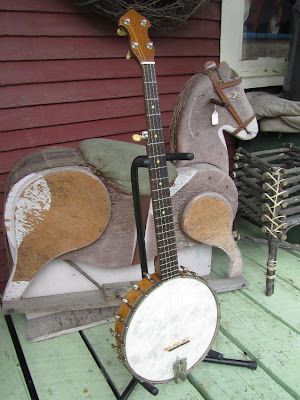c.1920 Gretsch (modified) 5-String banjo

This banjo started out as a pretty typical Gretsch-made teens/early 20s 5-string banjo, but has been hot-rodded with upgraded hardware from a slightly later Slingerland MayBell tenor banjo which had seen some rough times. This included ivoroid-buttoned friction tuners (and a new geared 5th peg with old ivoroid button), heavier-duty grooved tension hoop and heavier-duty L-shoe rim hardware, and a Grover tailpiece. I also installed the Slingerland's round-hoop style tonering for that louder, but sweet old-timey tone.
This has a 26" full scale and is setup to tune down to E (eBEG#B) below normal G tuning, per the customer's request. I put this together from a banjo I had purchased (the 5 string) and a banjo said customer had brought in. This union has proved fruitful, of course, and this is a nice-playing, great-sounding, plenty-loud instrument.
This has a 26" full scale and is setup to tune down to E (eBEG#B) below normal G tuning, per the customer's request. I put this together from a banjo I had purchased (the 5 string) and a banjo said customer had brought in. This union has proved fruitful, of course, and this is a nice-playing, great-sounding, plenty-loud instrument.

New bone nut. The neck looks like some sort of grungy poplar? or some sort, as the finish is "natural." I sanded the back of the neck bare, then polished it out, sprayed a coat or two of sealer, then polished that out, to make a somewhat "speed neck" which improves playability.

Simple celluloid dots in the board. Note that I moved the 5th string pip over for better string spacing.


Proper back-angle with the modified setup gave me a nice 5/8" tall bridge.

These very simple tailpieces give nice tone as the down-angle is much better than simply from the rim's edge.

Good, heavy-duty hardware.


Pot is laminated maple and is original to the neck, though the Slingerland hardware came from an identically-sized rim with an identical number of hooks.



This is sort of a "sleeper" banjo. The Gretsch-made rim is lighter than the Slingerland which makes this way more comfortable to hold over time but one still gets the same nice tone due to the heavy hoop tonering.

Because of the changed position of the neck (had to recut the dowel hole at the heel slightly higher for clearance of the tonering) I had to add a washer to shim up a slightly loose joint. I had also reset this neck's dowel stick as well, which provided a more natural angle for the heel join.


A winner!

Comments